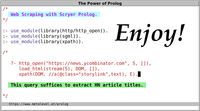Prolog Web Applications
Prolog is extremely well suited for
developing web applications. Web pages are naturally
represented as Prolog terms and can be
easily created, inspected and processed recursively.
| Video: |

|
We distinguish between client and server
applications. This page explains in more detail how to use Prolog
for these tasks.
Support for web development differs between Prolog systems. At the
most basic level, a few simple predicates that let us access
network streams, such as the predicates provided
by library(sockets)
in SICStus Prolog and Scryer Prolog, suffice to build
rudimentary web applications.
Of course, the most widely used Prolog
systems typically go far beyond this and ship with more thorough
and high-level support for such applications. For example,
SICStus Prolog and several other systems ship with the
PiLLoW
library for WWW programming. In SICStus, it is available
as
library(pillow).
Tau Prolog is a Prolog
interpreter written in JavaScript and can be seamlessly embedded
in web applications.
HTTP Clients
Fetching pages
A client fetches pages from a server. Using
Scryer Prolog, we can easily fetch a page via HTTP
and HTTPS
using http_open/3.
Example:
?- use_module(library(http/http_open)).
true.
?- http_open("https://www.metalevel.at/prolog", Stream, []).
Stream = '$stream'(0x7faed0412400)
This opens Stream for reading the page. The third
argument of http_open/3 is a list of options
that we can use to obtain header fields and control various
aspects of the connection.
Since the https scheme was specified in the example
above, a secure connection is automatically established
and used. You can
use library(tls)
to establish secure connections explicitly.
Parsing HTML
Once we obtain a stream handle for a web page, we can read the
page in several ways. For example, we can read one character at a
time or use a DCG to process the stream in
a pure way.
Very often, it is most convenient to convert the HTML page to
a Prolog term that reflects the page
structure in a uniform way. The
predicate load_html/3
performs this conversion:
?- http_open("https://www.metalevel.at/prolog", Stream, []),
load_html(stream(Stream), DOM, []).
Stream = ...,
DOM = [element(html, [], [element(head, [], [element(title, ...)])])].
See
library(sgml)
for more information, and related predicates for parsing markup
languages like XML.
Processing HTML
Plain Prolog already makes it extremely convenient to process such
a nested list of SGML elements, where each element is
represented as element(Name, Attributes,
Content). We could simply process such structures
recursively, using built-in
Prolog features.
Amazingly, we can do even better: In
Scryer Prolog, library(xpath)
allows us to access HTML elements via terms inspired by the
XPath
query language in a straight-forward way.
For example, let us obtain the text of all list items that
appear on a page, in continuation of the previous example:
?- use_module(library(sgml)),
use_module(library(xpath)).
true.
?- http_open("https://www.metalevel.at/prolog", Stream, []),
load_html(stream(Stream), DOM, []),
xpath(DOM, //li(text), Item).
Stream = ..., DOM = ..., Item = "Introduction"
; Stream = ..., DOM = ..., Item = "Facets of Prolog"
; Stream = ..., DOM = ..., Item = "Logical Foundations"
; Stream = ..., DOM = ..., Item = "Basic Concepts"
; Stream = ..., DOM = ..., Item = "Data Structures"
; ... .
On backtracking, all solutions are reported.
HTTP Servers
For server applications, we can use for example
the HTTP server
library of Scryer Prolog.
To get started, consider a very rudimentary HTTP server:
:- use_module(library(http/http_server)).
run(Port) :-
http_listen(Port, [get(/, request_response)]).
request_response(_, Response) :-
http_status_code(Response, 200),
http_body(Response, text("Hello!")).
The snippet implements a server that simply responds
with Hello!.
To run the server, copy the snippet to server.pl,
and start the server for example on port 3040 using:
$ scryer-prolog -g "run(3040)" server.pl
Once the server is running, you can test it by browsing
to http://127.0.0.1:3040.
In a more realistic
HTTP server, the response will of course depend on the actual
request of the client. Using different or additional
handlers, you can change the behaviour of the server.
For HTTP server applications, also
consider SWI-Prolog, a
Prolog dialect with excellent support for robust and efficient
multithreading. See
its HTTP server libraries
for more information. To run Prolog-based HTTPS servers with
SWI-Prolog, see LetSWICrypt.
Proloxy is a
Prolog-based proxy that uses extensible Prolog clauses
for flexible configurations.
Client/Server Applications
Pengines
allow us to implement powerful client/server applications in Prolog.
Using Pengines, you can query a remote Prolog server as if it
were local, using its results in client Prolog programs or web
pages with JavaScript.
For example, consider again the animal identification task
described in Expert
Systems. We can implement it as a client/server application with:
Importantly, the application logic resides completely on the
server.
See RITS for an example of a more
complex application.
See also Pengine's
successor, Web
Prolog, and the upcoming
book Web Prolog
and the programmable Prolog Web by Torbjörn Lager.
More about Prolog
Main page

